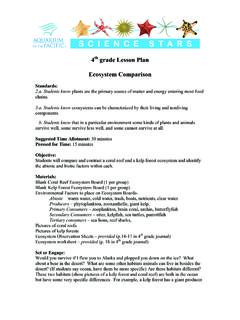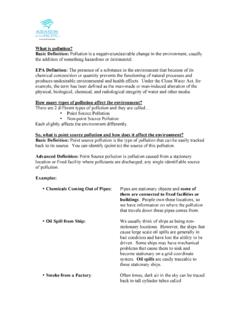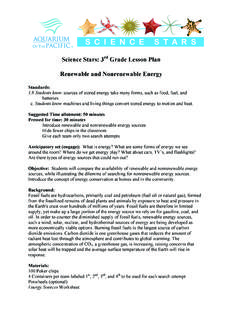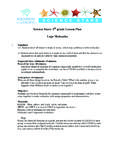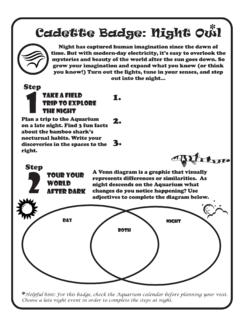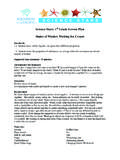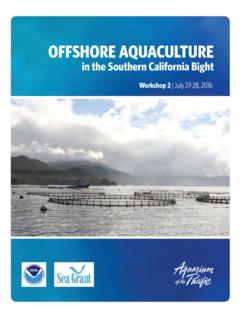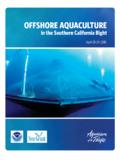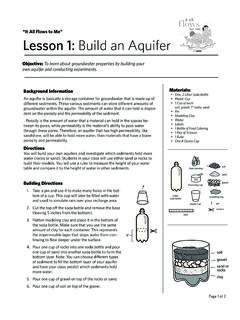Transcription of Scavenger Hunt - Aquarium of the Pacific
1 Thank you for choosing the Aquarium of the Pacific as your field trip destination! We are excited to share the wonders of the Pacific with you and your class. Use this Scavenger hunt to make the most of your students visit to the Aquarium . Inside this packet are vocabulary words, activities, and background information to make your field trip a fun and educational experience for your students. Simply make a photocopy of the following pages (double sided please!) and hand out one copy to each student the day of your visit. All of the answers to the questions can be found in the galleries on signs, from our knowledgeable volunteers, or in our informative presentations. We also have a helpful answer key available on our website at Here are a few hints to keep in mind before your may want to review the vocabulary page as homework before your Aquarium visit. This activity will be a fun way to introduce your students to the Aquarium and prepare them for all that they will experience.
2 The tile rubbings pages are for the brass tiles that you will find in front of the preview exhibits in the Great Hall. Let the students choose a favorite and make a rubbing with a crayon or pencil. Bring along a few old crayons without the wrappers to make the rubbings. The gallery pages will guide you to some of our key exhibits and give your students activities to make their visit more interactive and educational. The final page in this packet contains some pre-post activities for your students. These standards-based activities are a great way to prepare your students for their visit as well as reinforce what they learned while at the Aquarium . Thank you for coming to the Aquarium of the Pacific ! 3-5 Aquarium OF THE PACIFICT eacher PageScavenger HuntTeacher Page! 3-5 Aquarium OF THE PACIFIC1 Select the appropriate word from the word bank below to fill in the blanks in the sentences.
3 Once all the blanks are filled in, place the letters in the numbered slots into the phrase at the bottom of the page to read the secret message. Adaptation Echolocation Omnivore Algae Food chain Plankton Baleen Habitat Predator Camouflage Herbivore Prey Carnivore Invertebrate Vertebrate Cetaceans Mammal1. are hairy plates inside the mouth of a whale used for filtering food from the An animal that eats other animals is called a .3. Marine mammals such as whales and dolphins are called .4. is a type of sonar that toothed whales use to locate prey by making special sounds and listening to their An animal that is warm-blooded, has hair, breathes air, gives live birth, and nurse its young with milk is called a .6. are aquatic plants and animals, generally tiny, that drift with ocean An animal that captures and eats other animals is called a .8. An is a feature of an organism that allows it to better survive in its is a behavior, shape, coloration, and/or pattern that helps a plant or ani-mal blend in with its A is when smaller organisms are eaten by larger organisms which are in turn eaten by even larger An animal that eats only plants is called a.
4 12. An animal that does not have a spinal column or backbone is called an .13. An animal that eats both plants and animals is called an .14. An animal that is captured and eaten by another animal is called .15. A is an animal with a spinal column or is a primitive plant-like organism often referred to as A is the place where a plant or animal lives, its home. What kind of noise annoys an oyster? Answer:Word Bank:71331016521111289201417422612191815 231 2 3 4 5 6 7 8 9 5 10 11 12 13 14 6 5 15 16 17 6 5 18 19 20 21 22 5 23 Voc abulary 3-5 Aquarium OF THE PACIFIC2 _____whales are the _____ animal on the planet! Our model is 88 feet long, but these whales can reach lengths up to _____ feet (about the size of 3 _____and weigh up to 300,000 pounds. The African _____is the largest animal that lives on land and weighs about 8,000 pounds. Just the _____ of the blue whale weighs that much!)
5 The heart of the blue whale is about the size of a _____. Blue whales love to eat a type of plankton called krill, tiny shrimp-like crustaceans that float in the ocean. They take in large quantities of _____(up to _____gallons at once) and strain the tiny animals through their baleen. Baleen are hairy plates that hang from the upper _____of the whale and look like a mustache inside its mouth. The baleen catches all the krill while it lets the _____out. Then the whale takes its elephant-sized tongue and licks its food-coated baleen clean!Actual Paragraph: Blue whales are the largest animal on the planet! Our model is 88 feet long, but these whales can reach lengths up to 110 feet (about the size of 3 school buses) and weigh up to 300,000 pounds. The African elephant is the largest animal that lives on land and weighs about 8000 pounds. Just the tongue of the blue whale weighs that much! The heart of the blue whale is about the size of a Honda Civic!
6 Blue whales love to eat a type of plankton called krill, tiny shrimp-like crustaceans that float in the ocean. They take in large quantities of water (up to 17,000 gallons at once) and strain the tiny animals through their baleen. Baleen are hairy plates that hang from the upper jaw of the whale and look like a mus-tache inside its mouth. The baleen catches all the krill while it lets the water out. Then the whale takes its elephant-sized tongue and licks its food-coated baleen clean!(Type of Vehicle) (Animal)(Brand of Automobiles) (Liquid) (Number) (Body Part) (Same Liquid) (Color)Blue Whale Fill in the blanks with your own funny words! Or complete the story using the words below to learn about the blue whale.(Adjective)(Number)(Body Part)3 Tile Rubbing Page4 Tile Rubbing Page 3-5 Aquarium OF THE PACIFIC5A fish s body shape gives important clues about where the fish lives and how it moves.
7 There are five main body shapes for each of the following shapes to the fish that best represents that long, tubular and flexible. These fish are slow swimmers, but they can easily maneuver through cracks and crevices. For example: gunnel and moray shaped like a football. These fish are fast swimmers and are usually found swimming out in the open ocean at the midwater level. For exam-ple: mackerel, yellowtail, and kelp elongated. These fish are usually found near the surface of the water. They tend to be ambush hunters; they wait motionless until prey swims by, then attack. For example: flat pancake-like. These fish often live near the bottom of the ocean and can camouflage themselves in the sand. For example: flattened from side to side. These fish can maneuver quickly in and out of narrow hiding places such as a coral reef. For example: garibaldi and BajaSouthern Fishy ShapesBlack Sea Bass 3-5 Aquarium OF THE PACIFIC6At first glance, seals and sea lions look a lot alike.
8 They both have sleek, streamlined bodies, a thick layer of blubber, highly sensitive whiskers, and excellent hearing, especially under water. But while they do share some physical traits, seals and sea lions also have significant differences. Can you match the following physical characteristics to the correct animal? External ear flaps No external ear flaps Long front flippers Short front flippers Short neck Long neck Propel with front flippers and steer with the hind flippers Propel with hind flippers and steer with the front flippers Clumsy on land Moves easily on landCalifornia BajaSouthern Seals and Sea LionsHarbor SealCalifornia Sea Lion 3-5 Aquarium OF THE PACIFIC7 Sharks are amazing predators! Their streamlined shape and heightened senses make them excellent hunters. Their teeth are designed to grind, grab, or tear off chunks of meat. Their fins steer, stabilize, and push them through the water.
9 Look closely at the sharks in the large window at Shark Lagoon. Compare them to the shark below. If a leopard shark swam in a straight line head to tail with a black tip reef shark, which shark would the two together be as large as? _____How much longer is a whale shark than a great white shark? How many bamboo sharks would that equal? _____ How much larger is a great white shark than a horn shark? How many leopard sharks does that equal? _____How many pygmy sharks would it take to equal the length of one whale shark? Horn shark? _____The length of two blue sharks minus the length of a horn shark is the length of which shark ? _____Shark LagoonShark MathMissing PartsHorn Shark Egg CaseDid you know that there are over 360 different species of sharks in the oceans? Sharks come in a variety of different sizes, from the tiny pygmy shark that is less than a foot in length to the whale shark that can grow to 50 feet!
10 Using the following shark lengths, solve the math problems below. Shark Length Whale shark 50 ftGreat White shark 22 ftSawfish 21 ftBlue shark ftBlacktip reef shark ftLeopard shark 6 ftHorn shark 4 ftBamboo Shark ftPygmy shark 10 inWhat is the shark missing? Can you draw and label the missing parts?labellabellabel 3-5 Aquarium OF THE PACIFIC8 Feathers keep them warm, wings let them soar, and their webbed feet help them swim. Diving birds have many amazing adaptations, but they don t have an adaptation that helps them pull free of trash when they are tangled up. Our trash and nets trap and kill thousands of sea birds each year. Can you help the puffin navigate from the open ocean to its cliffside home while avoiding all the trash? Open oceanCliffside homeNorthern PacificDiving Birds 3-5 Aquarium OF THE PACIFIC9 Sea otters are mammals. They breathe air, have hair, do not lay eggs, nurse their young with milk, and are warm blooded.
